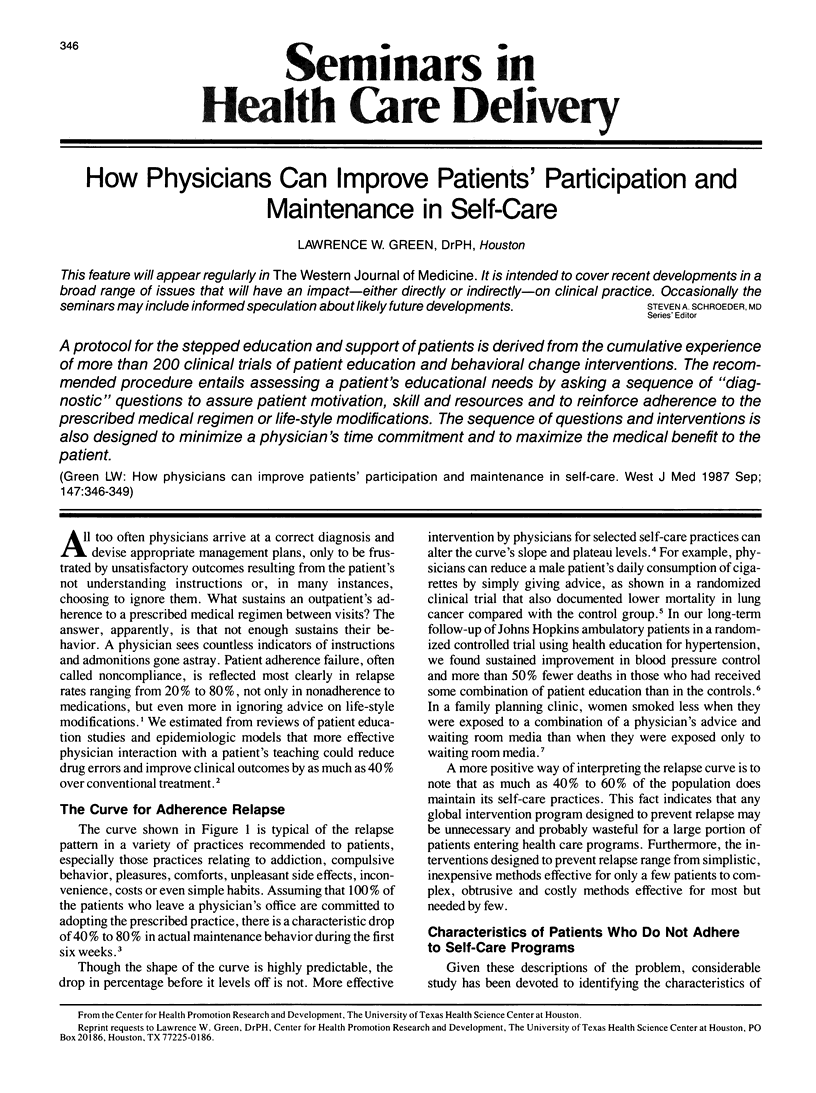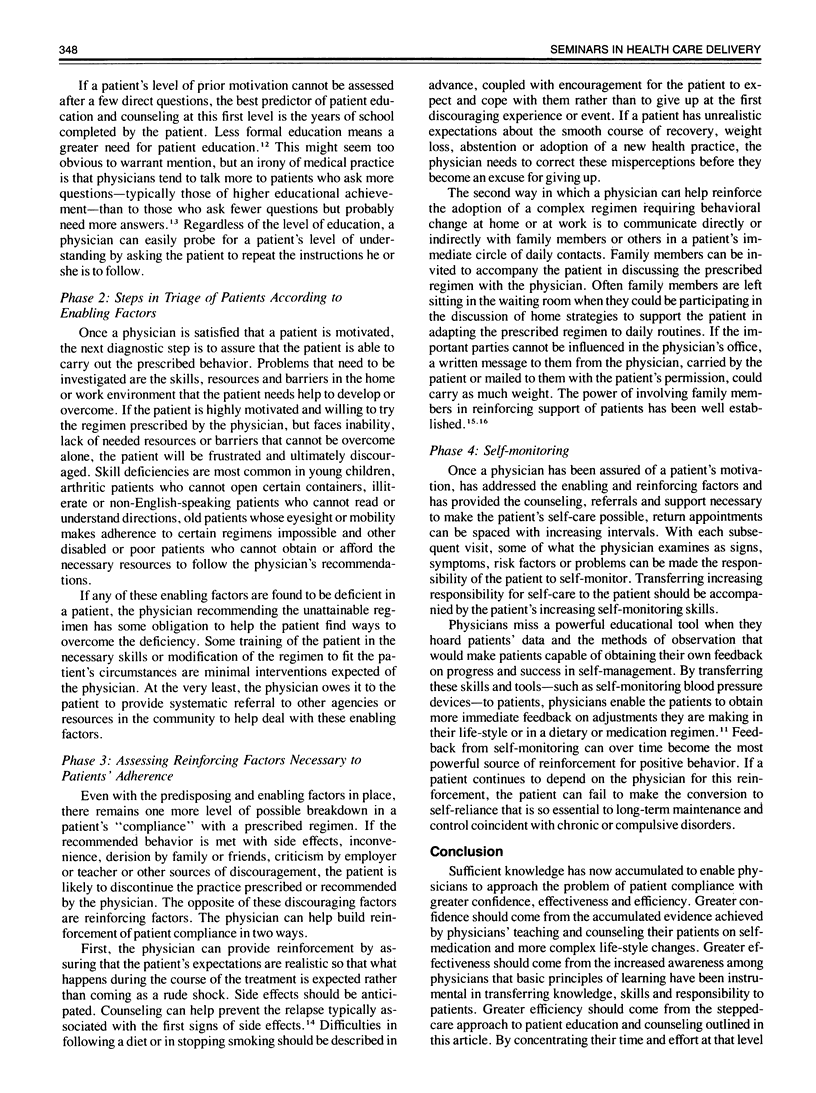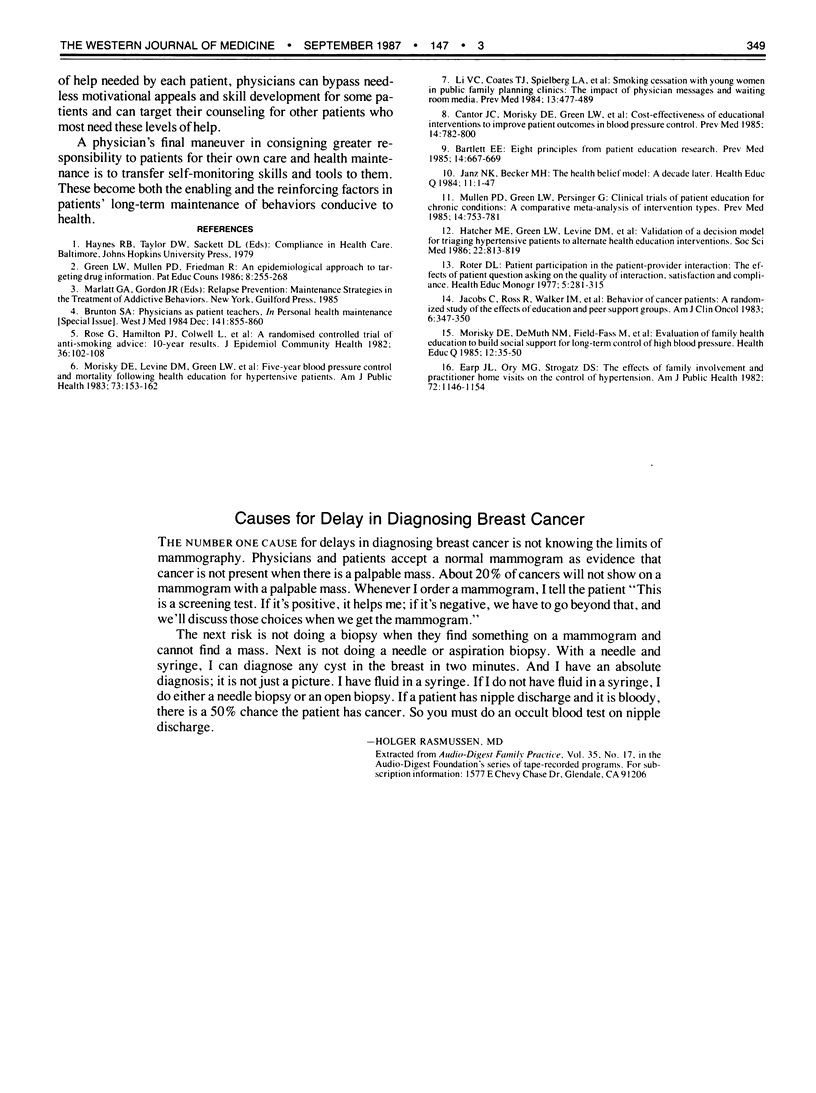Abstract
A protocol for the stepped education and support of patients is derived from the cumulative experience of more than 200 clinical trials of patient education and behavioral change interventions. The recommended procedure entails assessing a patient's educational needs by asking a sequence of “diagnostic” questions to assure patient motivation, skill and resources and to reinforce adherence to the prescribed medical regimen or life-style modifications. The sequence of questions and interventions is also designed to minimize a physician's time commitment and to maximize the medical benefit to the patient.
Full text
PDF



Selected References
These references are in PubMed. This may not be the complete list of references from this article.
- Brunton S. A. Physicians as patient teachers. West J Med. 1984 Dec;141(6):855–860. [PMC free article] [PubMed] [Google Scholar]
- Cantor J. C., Morisky D. E., Green L. W., Levine D. M., Salkever D. S. Cost-effectiveness of educational interventions to improve patient outcomes in blood pressure control. Prev Med. 1985 Nov;14(6):782–800. doi: 10.1016/0091-7435(85)90071-4. [DOI] [PubMed] [Google Scholar]
- Earp J. A., Ory M. G., Strogatz D. S. The effects of family involvement and practitioner home visits on the control of hypertension. Am J Public Health. 1982 Oct;72(10):1146–1154. doi: 10.2105/ajph.72.10.1146. [DOI] [PMC free article] [PubMed] [Google Scholar]
- Green L. W., Mullen P. D., Friedman R. B. An epidemiological approach to targeting drug information. Patient Educ Couns. 1986 Sep;8(3):255–268. doi: 10.1016/0738-3991(86)90004-2. [DOI] [PubMed] [Google Scholar]
- Hatcher M. E., Green L. W., Levine D. M., Flagle C. E. Validation of a decision model for triaging hypertensive patients to alternate health education interventions. Soc Sci Med. 1986;22(8):813–819. doi: 10.1016/0277-9536(86)90235-2. [DOI] [PubMed] [Google Scholar]
- Li V. C., Coates T. J., Spielberg L. A., Ewart C. K., Dorfman S., Huster W. J. Smoking cessation with young women in public family planning clinics: the impact of physician messages and waiting room media. Prev Med. 1984 Sep;13(5):477–489. doi: 10.1016/0091-7435(84)90016-1. [DOI] [PubMed] [Google Scholar]
- Morisky D. E., DeMuth N. M., Field-Fass M., Green L. W., Levine D. M. Evaluation of family health education to build social support for long-term control of high blood pressure. Health Educ Q. 1985 Spring;12(1):35–50. doi: 10.1177/109019818501200104. [DOI] [PubMed] [Google Scholar]
- Morisky D. E., Levine D. M., Green L. W., Shapiro S., Russell R. P., Smith C. R. Five-year blood pressure control and mortality following health education for hypertensive patients. Am J Public Health. 1983 Feb;73(2):153–162. doi: 10.2105/ajph.73.2.153. [DOI] [PMC free article] [PubMed] [Google Scholar]
- Mullen P. D., Green L. W., Persinger G. S. Clinical trials of patient education for chronic conditions: a comparative meta-analysis of intervention types. Prev Med. 1985 Nov;14(6):753–781. doi: 10.1016/0091-7435(85)90070-2. [DOI] [PubMed] [Google Scholar]
- Rose G., Hamilton P. J., Colwell L., Shipley M. J. A randomised controlled trial of anti-smoking advice: 10-year results. J Epidemiol Community Health. 1982 Jun;36(2):102–108. doi: 10.1136/jech.36.2.102. [DOI] [PMC free article] [PubMed] [Google Scholar]
- Roter D. L. Patient participation in the patient-provider interaction: the effects of patient question asking on the quality of interaction, satisfaction and compliance. Health Educ Monogr. 1977 Winter;5(4):281–315. doi: 10.1177/109019817700500402. [DOI] [PubMed] [Google Scholar]


